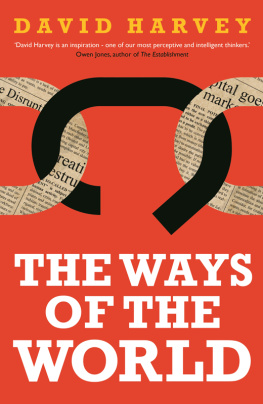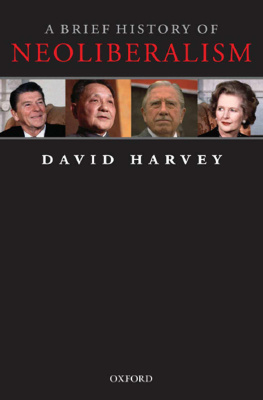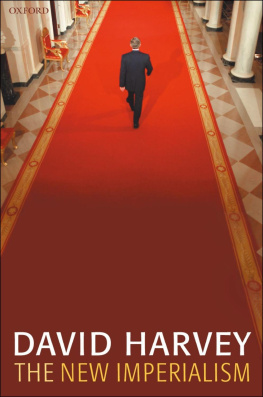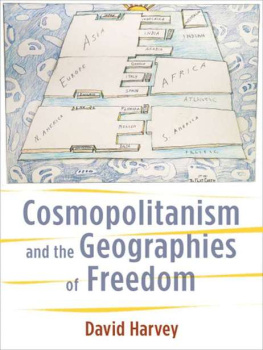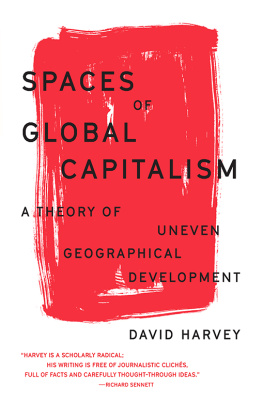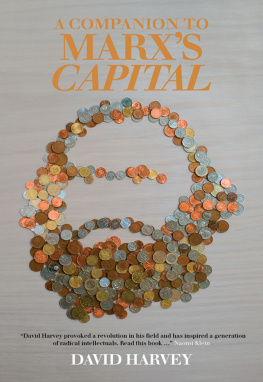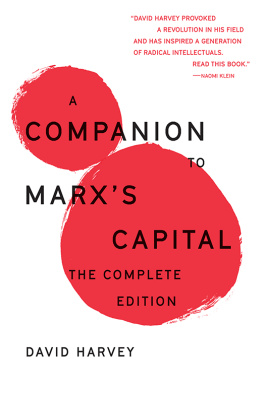The Ways of the World
DAVID HARVEY is Distinguished Professor of Anthropology at the City University of New York Graduate School where he has taught since 2001. His course on Marxs Capital, developed with students over forty years, has been downloaded by over two million people since appearing on the CUNY website in mid-2008. His books The Enigma of Capital (2010) and Seventeen Contradictions and the End of Capitalism (2013) were published by Profile to international acclaim.
ALSO BY DAVID HARVEY
Explanation in Geography
Social Justice and the City
The Limits to Capital
The Urbanisation of Capital
Consciousness and the Urban Experience
The Urban Experience
The Condition of Postmodernity
Justice, Nature and the Geography of Difference
Spaces of Hope
Spaces of Capital
The New Imperialism
Paris, Capital of Modernity
A Brief History of Neoliberalism
Spaces of Global Capitalism
Cosmopolitanism and the Geographies of Freedom
A Companion to Marxs Capital, volumes I and II
The Enigma of Capital, and the Crises of Capitalism
Rebel Cities
Seventeen Contradictions and the End of Capitalism
The Ways of the World
DAVID HARVEY

First published in Great Britain in 2016 by
PROFILE BOOKS LTD
3 Holford Yard
Bevin Way
London WC1X 9HD
www.profilebooks.com
Copyright David Harvey, 2016
The moral right of the author has been asserted.
All rights reserved. Without limiting the rights under copyright reserved above, no part of this publication may be reproduced, stored or introduced into a retrieval system, or transmitted, in any form or by any means (electronic, mechanical, photocopying, recording or otherwise), without the prior written permission of both the copyright owner and the publisher of this book.
A CIP catalogue record for this book is available from the British Library.
eISBN 978 1 78283 197 6
Picture Credits
Foreword
Ive been lucky enough to be involved in publishing many of David Harveys books, from his first in 1969 to this one forty-seven years later. The former was Explanation in Geography, in which he recast the ways geographers collected, classified and interpreted data and how they generalised and based theories on it. He did so in the light of a range of other disciplines, especially philosophy, statistics and mathematics. He sought to bring what he called decent intellectual standards for rational argument to geographical methodology and theorising. The book was a tour de force and swiftly acclaimed throughout the world. Harvey finished it while a lecturer in the Department of Geography at Bristol University. By the time it was published he had become an associate professor in the Department of Geography and Environmental Engineering at the Johns Hopkins University in Baltimore. Here his experience of the city in the aftermath of the 1968 riots dramatically changed the focus of his research and marked the start of his long association with the works of Karl Marx. The transition became evident two years later in Revolutionary and Counter-Revolutionary Theory in Geography and the Problem of Ghetto Formation, published here as . Its subject is in marked contrast to the book that preceded it, but Harveys concern for the meticulous collection and analysis of data and rigorous interpretation of its significance for theory and practice is just as evident in both. It has remained characteristic of his work ever since.
In his commmentary on predecessor, Harvey is a brillantly perceptive analyst of capitals history and adaptability, even as he diagnoses the causes of its crises and the inevitability of its demise.
My own favourites among the books many high points include the account of what lies behind the building of Sacr-Coeur in Paris in of the strike by car workers in Oxford that moves from an analysis of the tensions between local action and global causes to a close consideration of the novels of Raymond Williams, as well as the theme recurring throughout the book of how problems of over-accumulation spill over, all too visibly, into unbridled urbanisation and the social ills that go with it.
This cornucopia of David Harveys writing from every period, thus far, of his long and productive career will appeal to everyone already familiar with his work as much as it will to those coming to it for the first time.
John Davey
Oxford, August 2015
Introduction
Some astonishing news reports are coming out of China. The United States Geological Survey, which keeps tabs on these things, reports that China consumed 6,651 million tonnes of cement in the years 201113 compared with the 4,405 million tonnes the United States used over the period 19001999. In the United States we have poured a lot of concrete, but the Chinese must be pouring it everywhere at unconscionable rates. How and why could this be? And with what environmental, economic and social consequences?
These are the kinds of questions that this book is designed to shed light on. So let us look at the context of this bare fact and then consider how we can create a general framework for understanding what is happening.
The Chinese economy faced a serious crisis in 2008. Its export industries fell on hard times. Millions of workers (30 million by some estimates) were laid off because consumer demand in the United States (the chief market for Chinese goods) had fallen off a cliff: millions of households in the US either lost or were threatened with losing their homes to foreclosure and they were certainly not rushing out to the shopping malls to buy consumer goods. The property boom and bubble in the United States from 2001 to 2007 was a response to the crash of the earlier dot-com stock market bubble in 2001. Alan Greenspan, Chair of the US Federal Reserve, then engineered low interest rates so capital being rapidly withdrawn from the stock market moved into the property market as its preferred destination until the property bubble burst in 2007. Thus do the crisis tendencies of capital get moved around. The crisis of 2008, manufactured mainly in the housing markets of the American South-West (California, Arizona and Nevada) and South (Florida and Georgia) produced millions of unemployed workers in the industrial regions of China by early 2009.
The Chinese Communist Party knew it had to put all those unemployed workers back to work or face the threat of massive social unrest. By the end of 2009 a detailed joint study of the International Monetary Fund and the International Labour Organisation estimated that the net job loss in China as a result of the crisis was around 3 million (compared to 7 million in the United States). The Chinese Communist Party somehow managed to create around 27 million jobs in a year. This is a phenomenal, if not unprecedented, performance.
So what did the Chinese do and how did they do it? They engineered a massive wave of investment in physical infrastructures. These were designed in part to spatially integrate the Chinese economy by setting up communication links between the vibrant industrial zones of the East Coast with the largely underdeveloped interior, as well as improving connectivity between southern and northern industrial and consumer markets which had hitherto been rather isolated from each other. This was coupled with a vast programme of forced urbanisation, building whole new cities as well as expanding and reconstructing the developed ones.
This response to conditions of economic crisis was not new. Napoleon III brought Haussmann to Paris in 1852 to restore employment by rebuilding the city after the economic crash and revolutionary movement of 1848. The United States did the same after 1945 when it deployed much of its increased productivity and surplus cash to build the suburbs and metropolitan regions (in the style of Robert Moses) of all the major cities while also integrating the South and West into the national economy through the construction of the interstate highway system. The aim in both cases was to create relatively full employment for surpluses of capital and labour and thereby assure social stability. The Chinese after 2008 did the same but, as the data on cement consumption indicate, they did so through a shift in scale. Such a shift had also been seen before: Robert Moses worked at a far larger metropolitan region scale than Baron Haussmann, who focused on the city alone. After 2008 at least a quarter of Chinas GDP was derived from housing construction alone and when to this is added all the physical infrastructures (such as high-speed rail lines, highways, dam and water projects, new airports and container terminals, etc.), roughly half of Chinas GDP and almost all of its growth (which bordered on 10 per cent until recently) were attributable to investment in the built environment. This was how China got out of the recession. Hence the pouring of all that concrete.
Next page
